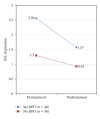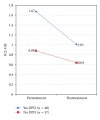Mood and Global Symptom Changes among Psychotherapy Clients with Depressive Personality
- PMID: 23304472
- PMCID: PMC3530796
- DOI: 10.1155/2012/208435
Mood and Global Symptom Changes among Psychotherapy Clients with Depressive Personality
Abstract
The present study assessed the rate of depressive personality (DP), as measured by the self-report instrument depressive personality disorder inventory (DPDI), among 159 clients entering psychotherapy at an outpatient university clinic. The presenting clinical profile was evaluated for those with and without DP, including levels of depressed mood, other psychological symptoms, and global severity of psychopathology. Clients were followed naturalistically over the course of therapy, up to 40 weeks, and reassessed on these variables again after treatment. Results indicated that 44 percent of the sample qualified for DP prior to treatment, and these individuals had a comparatively more severe and complex presenting disposition than those without DP. Mixed-model repeated-measures analysis of variance was used to examine between-groups changes on mood and global severity over time, with those with DP demonstrating larger reductions on both outcome variables, although still showing more symptoms after treatment, than those without DP. Only eleven percent of the sample continued to endorse DP following treatment. These findings suggest that in routine clinical situations, psychotherapy may benefit individuals with DP.
Figures


Similar articles
-
The Swedish Depressive Personality Disorder Inventory: psychometrics and clinical correlates from a DSM-IV and proposed DSM-5 perspective.Nord J Psychiatry. 2012 Jun;66(3):167-77. doi: 10.3109/08039488.2011.611251. Epub 2011 Sep 22. Nord J Psychiatry. 2012. PMID: 21936730
-
Do personality traits predict outcome of psychodynamically oriented psychosomatic inpatient treatment beyond initial symptoms?Br J Clin Psychol. 2015 Mar;54(1):109-25. doi: 10.1111/bjc.12064. Epub 2014 Aug 22. Br J Clin Psychol. 2015. PMID: 25145630
-
Treatment duration and premature termination of psychotherapy in personality disorders: predictive performance of psychodynamic personality functioning.J Psychiatr Pract. 2012 May;18(3):172-86. doi: 10.1097/01.pra.0000415074.43744.29. J Psychiatr Pract. 2012. PMID: 22617082
-
Efficacy of intensive short-term dynamic psychotherapy in mood disorders: A critical review.J Affect Disord. 2020 Aug 1;273:375-379. doi: 10.1016/j.jad.2020.04.002. Epub 2020 May 13. J Affect Disord. 2020. PMID: 32560931 Review.
-
A Preliminary Probe of Personality Predicting Psychotherapy Outcomes: Perspectives from Therapists and Their Clients.Psychopathology. 2018;51(2):122-129. doi: 10.1159/000487362. Epub 2018 Apr 10. Psychopathology. 2018. PMID: 29635236 Review.
References
-
- Lambert MJ, Ogles BM. The efficacy and effectiveness of psychotherapy. In: Lambert M, editor. Bergin and Garfield’s Handbook of Psychotherapy and Behavior Change. 5th edition. New York, NY, USA: Wiley; 2004. pp. 139–193.
-
- Roth A, Fonagy P. Depression. In: Roth A, Fonagy P, editors. What Works for Whom: A Critical Review of Psychotherapy Research. 2nd edition. Vol. 4. New York, NY, USA: The Guilford Press; 2005. pp. 66–134.
-
- Shedler J. The efficacy of psychodynamic psychotherapy. American Psychologist. 2010;65(2):98–109. - PubMed
-
- Cipriani A, Furukawa TA, Salanti G, et al. Comparative efficacy and acceptability of 12 new-generation antidepressants: a multiple-treatments meta-analysis. The Lancet. 2009;373(9665):746–758. - PubMed
-
- Keller MB, McCullough JP, Klein DN, et al. A comparison of nefazodone, the cognitive behavioral-analysis system of psychotherapy, and their combination for the treatment of chronic depression. New England Journal of Medicine. 2000;342(20):1462–1470. - PubMed
LinkOut - more resources
Full Text Sources

